

mailto: payer@hdm-stuttgart.de
Zitierweise / cite as:
Payer, Margarete <1942 - > ; Payer, Alois <1944 - >: Bibliothekarinnen Boliviens vereinigt euch! = Bibliotecarias de Bolivia ¡Uníos! : Berichte aus dem Fortbildungssemester 2001/02. -- Teil 1: Zur Landeskunde Boliviens. -- 4. Wirtschaft und Soziales. -- A. Anhang: Nutzpflanzen Boliviens. -- 1. Nahrungspflanzen. -- Fassung vom 2001-11-14. -- URL: http://www.payer.de/bolivien1/bolivien01411.htm. -- [Stichwort].
Erstmals publiziert:
Überarbeitungen:
Anlass: Fortbildungssemester 2001/02
Unterrichtsmaterialien (gemäß § 46 (1) UrhG)
©opyright: Dieser Text steht der Allgemeinheit zur Verfügung. Eine Verwertung in Publikationen, die über übliche Zitate hinausgeht, bedarf der ausdrücklichen Genehmigung der Herausgeberin.
Dieser Teil ist ein Kapitel von:
Payer, Margarete <1942 - >: Bibliothekarinnen Boliviens vereinigt euch! : Berichte aus dem Fortbildungssemester 2001/02. -- Teil 1: Zur Landeskunde Boliviens. -- URL: http://www.payer.de/bolivien1/bolivien01.htm
Dieser Text ist Teil der Abteilung Länder und Kulturen von Tüpfli's Global Village Library
Die Folgende Übersicht über die Wirtschaftspflanzen Boliviens beruht vor allem auf:
Cárdenas, Martín <1899 - 1973>: Manual de plantas economicas de Bolivia. -- 2. ed. -- La Paz [u.a.] : Los Amigos del Libro, 1989. -- 333 S. : Ill. -- ISBN 84-8370-155-3
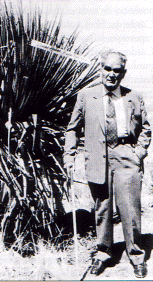
Abb.: Martín Cárdenas (1899 - 1973), ein Pionier der Botanik Boliviens
Diese Übersicht ist keineswegs vollständig, gibt aber einen guten Überblick, wie reich die Nutzpflanzenwelt Boliviens ist.
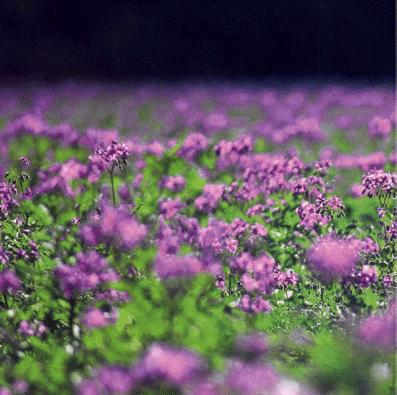
Abb.: Blühender Kartoffelacker, bei Cusco, Peru (©CIP)
Bezeichnungen: La papa (el papa ist der Papst)
Familie: Solanaceae -- Nachtschattengewächse
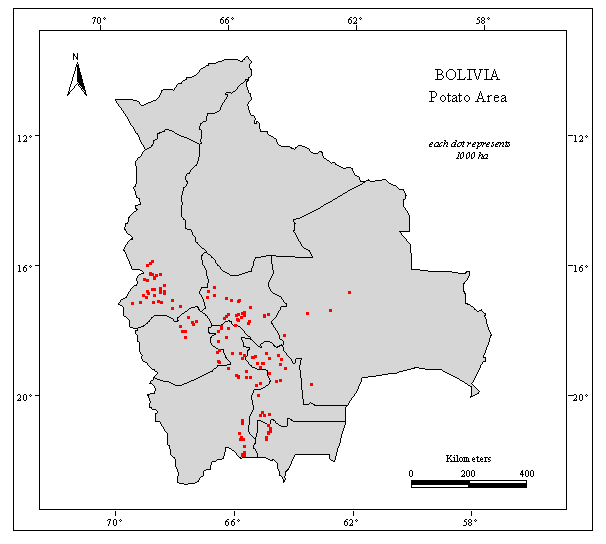
Abb.: Kartoffelanbaugebiete Boliviens (©CIP)
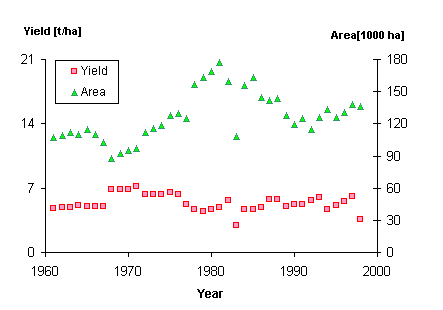
Abb.: Hektarertrag und mit Kartoffeln bebaute Fläche 1960 - 2000
(©CIP)
|
|
|
Papaliza / Ulluco (Ullucus tuberosus)
Einheimische Bezeichnungen: Papalisa, Ulluco
Familie: Bacellaceae
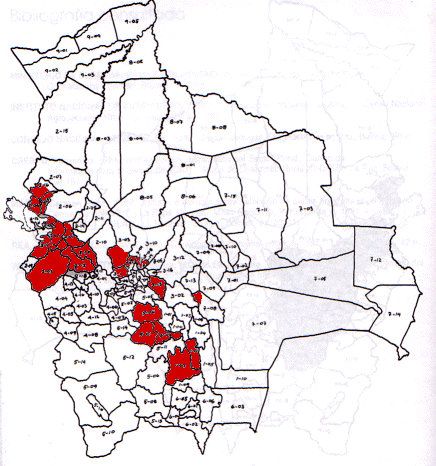
Abb.: Anbaugebiete von Papalisa in Bolivien
[Bildquelle: Aquilar R., Alberto: Guia bibliográfica sobre tubérculos Andinos en Bolivia. -- Cochabamba : AGRUCO, 1997. -- Depósito legal 2-1-004-97. -- S. 16]
|
|
|
Weiterführende Internetressource:
Pocket guide to nine exotic Andean roots and tubers / CIP. -- URL: http://www.cipotato.org/market/artguide/artguide1.htm. -- Zugriff am 2001-09-02
Oca (Oxalis tuberosa)
Bezeichnungen: La oca
Familie: Oxalidaceae -- Sauerkleegewächse
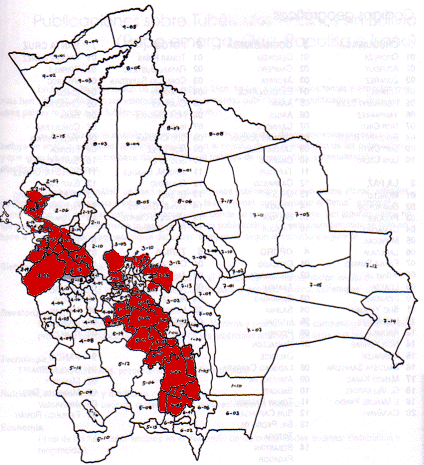
Abb.: Anbaugebiete von Oca in Bolivien
[Bildquelle: Aquilar R., Alberto: Guia bibliográfica sobre tubérculos Andinos en Bolivia. -- Cochabamba : AGRUCO, 1997. -- Depósito legal 2-1-004-97. -- S. 17]
|
|
|
| [Bildquelle: http://www.cipotato.org/market/artguide/artguide2.htm. -- Zugriff am 2001-09-02] | |
|
|
|
Weiterführende Internetressource:
Pocket guide to nine exotic Andean roots and tubers / CIP. -- URL: http://www.cipotato.org/market/artguide/artguide2.htm. -- Zugriff am 2001-09-02
Knollige Kapuzinerkresse (Tropaeolum tuberosum)
Einheimische Bezeichnungen: Isaño, Mashua, Cubio
Familie: Tropaeolaceae -- Kapuzinerkressengewächse
|
|
|
| [Bildquelle: http://www.cipotato.org/market/artguide/artguide3.htm. -- Zugriff am 2001-09-02] | |
Weiterführende Internetressource:
Pocket guide to nine exotic Andean roots and tubers / CIP. -- URL: http://www.cipotato.org/market/artguide/artguide3.htm. -- Zugriff am 2001-09-02
(Arracacia xanthorrhiza)
Bezeichnungen: Aracacha
Familie: Arracacianae
|
|
|
| [Bildquelle: http://www.cipotato.org/market/artguide/artguide4.htm. -- Zugriffam 2001-09-02] | |
Weiterführende Internetressource:
Pocket guide to nine exotic Andean roots and tubers / CIP. -- URL: http://www.cipotato.org/market/artguide/artguide4.htm. -- Zugriffam 2001-09-02
Maniok (Manihot utilissima oder esculenta)
Bezeichnungen: Yuca
Familie: Euphorbiaceae -- Wolfsmilchgewächse
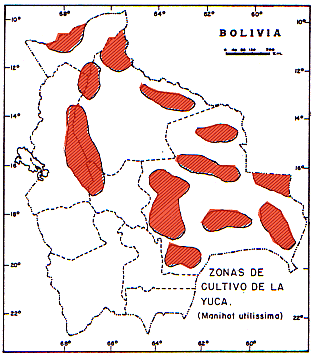
Abb.: Anbaugebiete von Maniok
[Kartenvorlage: Muñoz Reyes, Jorge <1904 - 1984>: Geográfia escolar de Bolivia. -- 3. ed., actualizada. -- La Paz : Juventud, 1997. -- Depósito legal 4-1-068/81. -- S. 151]
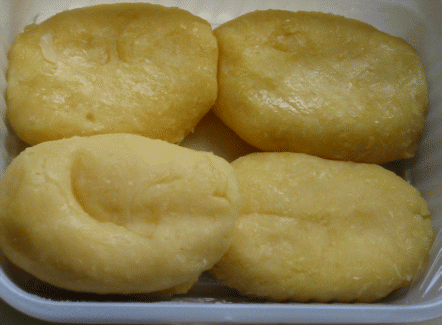
Abb.: Croquetas de yuca rellenas con queso -- mit Käse gefüllte
Maniokkroquetten (Bild: Payer)
Süßkartoffel (Ipomoea batatas)
Bezeichnungen: Camote, Batata dulce
Familie: Convolvulaceae -- Windengewächse
Taro (Xanthosoma sagittifolia)
Bezeichnungen: Gualusa
Familie: Araceae -- Aronstabgewächse
Indisches Blumenrohr (Canna edulis)
Bezeichnungen: Achira
Familie: Cannaceae -- Blumenrohrgewächse
|
|
|
| [Bildquelle: http://www.cipotato.org/market/artguide/artguide7.htm. -- Zugriff am 2001-09-02] | |
Weiterführende Internetressource:
Pocket guide to nine exotic Andean roots and tubers / CIP. -- URL: http://www.cipotato.org/market/artguide/artguide7.htm. -- Zugriff am 2001-09-02
Yacon (Polymnia edulis)
Einheimische Bezeichnungen: Yacón, Llacón, Aricoma
Familie: Asteraceae (Compositae) -- Korbblütengewächse
|
|
|
|
| [Bildquelle: http://www.cipotato.org/market/artguide/artguide5.htm. -- Zugriff am 2001-09-02] | ||
Weiterführende Internetressource:
Pocket guide to nine exotic Andean roots and tubers / CIP. -- URL: http://www.cipotato.org/market/artguide/artguide5.htm. -- Zugriff am 2001-09-02
Topinambur (Pachyrrhizus ahipa)
Bezeichnungen: Ajipa
Familie: Fabaceae (Leguminosae) -- Hülsenfrüchtler
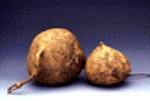
Abb.: Knollen von Topinambur (Pachyrrhizus ahipa) (©CIP)
[Bildquelle: http://www.cipotato.org/market/artguide/artguide8.htm.
-- Zugriff am 2001-09-02]
Weiterführende Internetressource:
Pocket guide to nine exotic Andean roots and tubers / CIP. -- URL: http://www.cipotato.org/market/artguide/artguide8.htm. -- Zugriff am 2001-09-02
Pfeilwurz (Maranta arundinacea)
Bezeichnungen: Jamachipeke
Familie: Marantaceae -- Pfeilwurzgewächse
Achacana (Neowerdermannia vorwerckii)
Bezeichnungen: Achacana
Familie: Cactaceae -- Kakteengewächse
Cipoy (Jacarantia hassleriana)
Bezeichnungen: Cipoy
Familie: Caricaceae
Totora (Scirpus riparius)
Bezeichnungen: Totora
Familie: Cyperaceae -- Riedgräser
Ñoke bzw. Amañoke (Juelia subterranea)
Einheimische Bezeichnungen: Ñoke, Amañoke
Familie: Balanophoraceae
Maca (Lepidium meyeni)
Bezeichnungen: Maca
Familie: Brassicaceae (Cruciferae) -- Kreuzblütler
|
|
|
|
| [Bildquelle: http://www.cipotato.org/market/artguide/artguide9.htm. -- Zugriff am 2001-09-02] | ||
Weiterführende Internetressource:
Pocket guide to nine exotic Andean roots and tubers / CIP. -- URL: http://www.cipotato.org/market/artguide/artguide9.htm. -- Zugriff am 2001-09-02
Mauka (Mirabilis expansa)
Bezeichnungen: Mauka
Familie: Nyctaginaceae

Abb.: Knollen von Mauka (Mirabilis expensa) [Bildquelle: http://www.cipotato.org/market/artguide/artguide6.htm.
-- Zugriff am 2001-09-02]
Weiterführende Internetressource:
Pocket guide to nine exotic Andean roots and tubers / CIP. -- URL: http://www.cipotato.org/market/artguide/artguide6.htm. -- Zugriff am 2001-09-02
Mais (Zea mays)
Bezeichnungen: Maíz
Familie: Poaceae (= Gramineae) -- Süßgräser
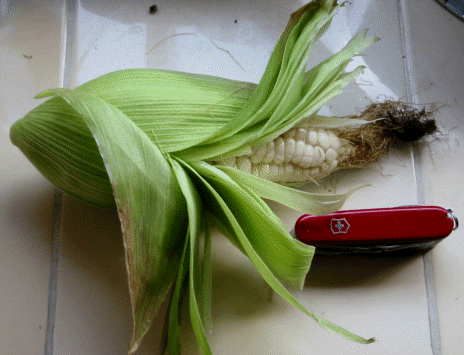
Abb.: Choclo = unreife Zea mays (Bild: Payer)
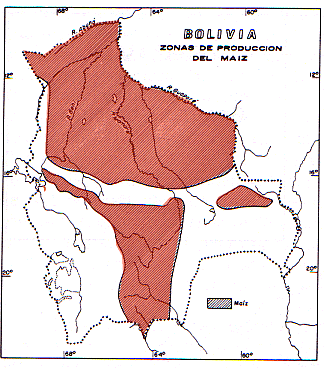
Abb.: Maisanbaugebiete
[Kartenvorlage: Muñoz Reyes, Jorge <1904 - 1984>: Geográfia escolar de Bolivia. -- 3. ed., actualizada. -- La Paz : Juventud, 1997. -- Depósito legal 4-1-068/81. -- S. 146]
Weizen (Triticum sativum L.)
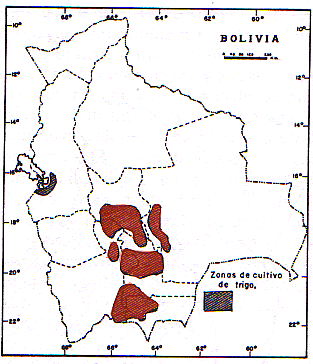
Abb.: Weizenanbaugebiete
[Kartenvorlage: Muñoz Reyes, Jorge <1904 - 1984>: Geográfia escolar de Bolivia. -- 3. ed., actualizada. -- La Paz : Juventud, 1997. -- Depósito legal 4-1-068/81. -- S. 146]
Sorghum (Sorghum vulgare Pers.)
Gerste (Hordeum vulgare L.)
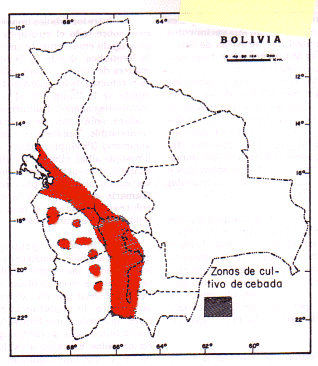
Abb.: Anbaugebiete der Gerste
[Kartenvorlage: Muñoz Reyes, Jorge <1904 - 1984>: Geográfia escolar de Bolivia. -- 3. ed., actualizada. -- La Paz : Juventud, 1997. -- Depósito legal 4-1-068/81. -- S. 143]
Reis (Oryza sativa L.)
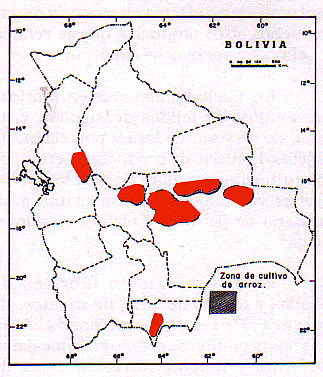
Abb.: Reisanbaugebiete
[Kartenvorlage: Muñoz Reyes, Jorge <1904 - 1984>: Geográfia escolar de Bolivia. -- 3. ed., actualizada. -- La Paz : Juventud, 1997. -- Depósito legal 4-1-068/81. -- S. 153]
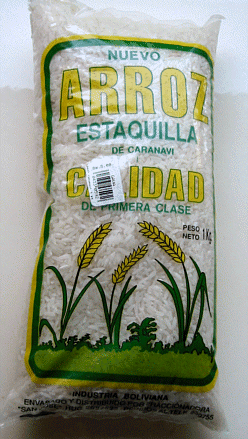
Abb.: Reis (Oryza sativa) (Bild: Payer)
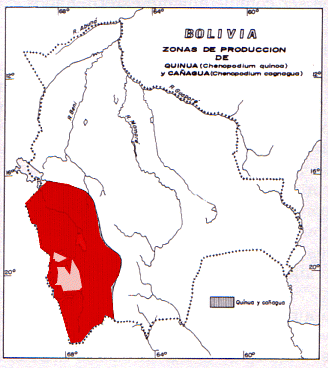
Abb.: Anbaugebiete von Quinoa und Kañahua
[Kartenvorlage: Muñoz Reyes, Jorge <1904 - 1984>: Geográfia escolar de Bolivia. -- 3. ed., actualizada. -- La Paz : Juventud, 1997. -- Depósito legal 4-1-068/81. -- S. 140]
Quinoa (Chenopodium quinoa)
Bezeichnungen: Quinoa
Familie: Chenopodiaceae -- Gänsefußgewächse
Zur Verwendung von Quinoa siehe:
Iñiguez de Barrios, Bethsabe <1918 - >: Mil delicias de la quinua. .. Oruro : Quelco, 1977. -- 368 S. : Ill.
|
|
|
|
|
Kañahua (Chenopodium pallidicaule)
Bezeichnungen: Kañahua
Familie: Chenopodiaceae -- Gänsefußgewächse
Gartenfuchsschwanz (Amaranthus caudatus)
Einheimische Bezeichnungen: Millmi, Coimi
Familie: Amaranthaceae -- Fuchschwanzgewächse
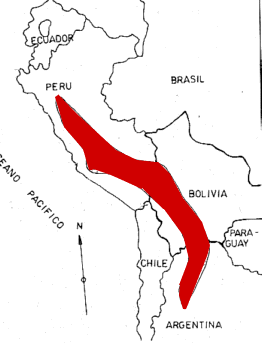
Abb.: Anbaugebiet des Amaranth
[Quelle: Kietz, Renate: Compendio del Amaranto : rescate y revitalización en Bolivia. -- La Paz : ILDIS, 1992.. -- Depósito legal 4-1-648-92. -- S. 104]
Zum Amaranth siehe:
Kietz, Renate: Compendio del Amaranto : rescate y revitalización en Bolivia. -- La Paz : ILDIS, 1992. -- 175 S. : Ill. -- Depósito legal 4-1-648-92
Pfefferschoten (Capsicum spp.)
Bezeichnungen: Ajíes
Familie: Solanaceae -- Nachtschattengewächse
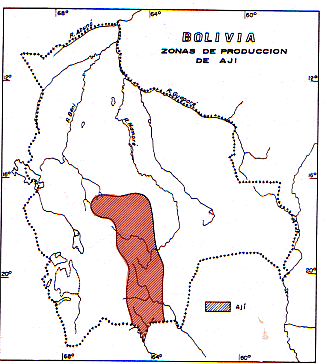
Abb.: Anbaugebiete von Pfefferschoten
[Kartenvorlage: Muñoz Reyes, Jorge <1904 - 1984>: Geográfia escolar de Bolivia. -- 3. ed., actualizada. -- La Paz : Juventud, 1997. -- Depósito legal 4-1-068/81. -- S. 146]
Quillquiña (Porophyllum ruderale)
Bezeichnungen: Quillquiña
Familie: Asteraceae (Compositae) -- Korbblütengewächse
(Tagetes graveolens)
Bezeichnungen:Suico, Wakatay, Chicchipa
Familie: Asteraceae (Compositae) -- Korbblütengewächse
(Hedeoma mandoniana)
Bezeichnungen: Orégano de altura
Familie: Lamiaceae (Labiatae) -- Lippenblütler
Erdnuss (Arachis hypogaea)
Bezeichnungen: el maní
Familie: Fabaceae (Leguminosae) -- Hülsenfrüchtler
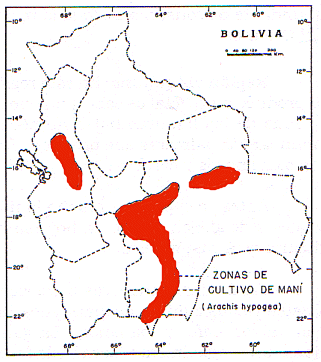
Abb.: Erdnussanbaugebiete
[Kartenvorlage: Muñoz Reyes, Jorge <1904 - 1984>: Geográfia escolar de Bolivia. -- 3. ed., actualizada. -- La Paz : Juventud, 1997. -- Depósito legal 4-1-068/81. -- S. 149]
Saubohne
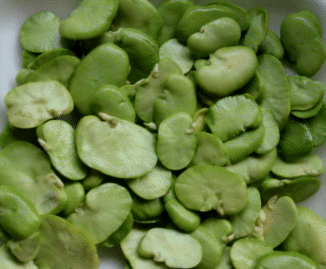
Abb.: Saubohnen (Bild: Payer)
Gartenbohne (Fisole) (Phaseolus vulgaris)
Einheimische Bezeichnungen: Purutu, Frejol
Familie: Fabaceae (Leguminosae) -- Hülsenfrüchtler
Canavalia (Canavalia endiformis)
Bezeichnungen: Canavalia
Familie: Fabaceae (Leguminosae) -- Hülsenfrüchtler
Lupine (Lupinus mutabilis)
Einheimische Bezeichnungen: Tauri, Tarhui
Familie: Fabaceae (Leguminosae) -- Hülsenfrüchtler
(Prosopis julifora)
Bezeichnungen: Ttako, Algarrobo
Familie: Fabaceae (Leguminosae) -- Hülsenfrüchtler
(Inga affinis Steud)
Bezeichnungen: Pacay
Familie: Fabaceae (Leguminosae) -- Hülsenfrüchtler
|
|
|
|
|
(Erythrina falcata)
Bezeichnungen: Ceibo, Chilicchi
Familie: Fabaceae (Leguminosae) -- Hülsenfrüchtler
(Hymenaea courbaril)
Bezeichnungen: Jaku huayaka, Paquio
Familie: Fabaceae (Leguminosae) -- Hülsenfrüchtler
(Cucurbita maxima Duch.)
Bezeichnungen: zapallo
Familie: Cucurbitaceae -- Kürbisgewächse
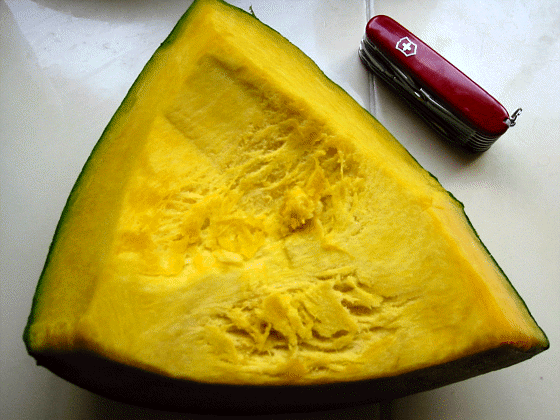
Abb.: Teil von Zapallo (Cucurbita maxima Duch. (Bild: Payer)
Kürbis (Cucurbita pepo)
Bezeichnungen: Escariote
Familie: Cucurbitaceae -- Kürbisgewächse
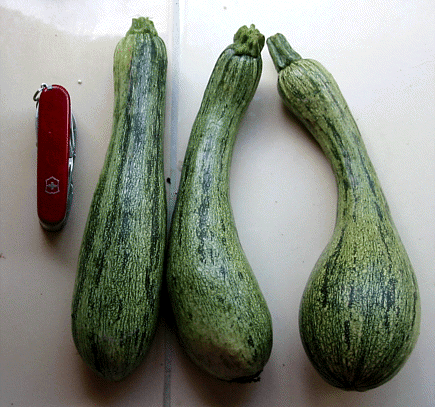
Abb.: Pepito (Cucurbita pepo) (Bild: Payer)
Bezeichnungen: Lacayote
Familie: Cucurbitaceae -- Kürbisgewächse
(Cucurbita moschata)
Bezeichnungen: Joko
Familie: Cucurbitaceae -- Kürbisgewächse
(Cyclanthera pedata)
Einheimische Bezeichnungen: Achokkhcha, Caygua
Familie: Cucurbitaceae -- Kürbisgewächse
(Sicana odorifera)
Bezeichnungen: Pavi
Familie: Cucurbitaceae -- Kürbisgewächse
(Lagenaria ciceraria)
Einheimische Bezeichnungen: Pulu pulu, Mati
Familie: Cucurbitaceae -- Kürbisgewächse
(Luffa cylindrica)
Bezeichnungen: Esponja vegetal
Familie: Cucurbitaceae -- Kürbisgewächse
(Momordica charantia)
Bezeichnungen: Balsamina
Familie: Cucurbitaceae -- Kürbisgewächse
Angaben im Folgenden vor allem nach der sehr nützlichen Übersicht:
Coppens d'Eeckenbrugge, Geo ;Libreros Ferla, Dimary: Fruits from Amaerica : an ethnobotanical inventory. -- URL: http://www.ciat.cgiar.org/ipgri/fruits_from_americas/frutales/cover.htm. -- Zugriff am 2001-10-04. -- [Leider ist dieses Werk bezüglich Boliviens absolut unzureichend und nimmt die wichtigste Literatur zur Nutzpflanzenkunde Boliviens nicht zur Kenntnis]
Englische Zitate -- falls nichts anderes angegeben -- stammen aus diesem Werk.
(Solanum muricatum Ait.)
Synonyme: Solanum variegatum Ruíz & Pavón, Solanum guatemalense Hort.
Bezeichnungen:
Sp: pepino, pepino blanco, pepino dulce (Colombia to Bolivia). mataserrano (Perú), peramelón (Canaries), pepino mango, pepino morado;
En: melon pear, pear melon, melon shrub, pepino, sweet cucumber;
Fr: melon-poire, poire-melon.
Cahum, xachum (Quechua),
kachuma (Aymara).
Familie: Solanaceae -- Nachtschattengewächse
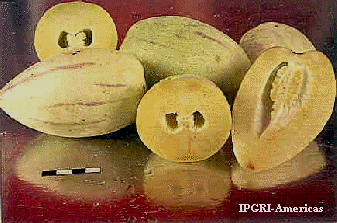
Abb.: Solanum muricatum (©IPGRI)
Vorkommen: Anden 900 bis 2800 m.. Kultiviert, nationale Märkte in Anden
Beschreibung: "Herbaceous shrub to 1 m, propagated by seeds or cuttings. Fruit ovoid to ellipsoid, 5-20 cm, green, white or yellow, with purple stripes; pulp white or yellow; flavor sweet to subacid; highly variable in quality. Some types from parthenocarpic fruits. Pulp very juicy."
Verwendung: "Pulp eaten fresh, canned, preserved. Moderate appeal. Good potential for commercial production. Considered diuretic, recommended for treating goitre because of its good iodine content."
(Solanum quitoense Lam.)
Synonym: Solanum angulatum R. & P.
Bezeichnungen: Naranjilla, Lulo
Sp: lulo, toronja (Colombia); naranjilla, naranjilla de Quito, nuqui (Ecuador), naranjilla de Castilla, ;
En: naranjilla, Quito orange;
Fr: naranjille, morelle de Quito;
Du: gele terong.
lulum (Quechua).
Familie: Solanaceae -- Nachtschattengewächse
|
|
|
| Abb.: Solanum quitoense (©IPGRI) | |
Vorkommen: Anden, frostfreie Gebiete 1500 bis 2800 m. Wild, kultiviert, moderne Züchtungen, nationale Märkte
Beschreibung: "Herbaceous-large-leaved shrub to 3 m, propagated by seeds or cuttings. Fruit disposed in clusters, globose to ovoid, 4-6 cm in diameter, yellow to orange, covered with brittle trichomes; pulp green, acid, and juicy, with many small seeds. Wild plants are spine."
Nutzung: "Too acid to be consumed in hand, the fruit is used to make juices and nectars, sherbets, jams, preserves and pastries. The green color of the fruit is an original advantage for the juice industry. However it has to be protected from oxidization, which makes it turn brown very quicky. The economic importance of naranjilla now compares with passion fruits and tree tomato on the Colombian and Ecuadorian markets."
(Physalis peruviana L.)
Synonym: Physalis edulis Sims.
Bezeichnungen:
Sp: uchuva (Colombia), amor en bolsa, aguaymanto, bolsa de amor, capulí, cereza del Perú, cuchuva, sacabuche, tomate silvestre, tomate verde, topotopo, uvilla, yuyo de ojas, motojobobo embolsado;
Po: camapum, batetesta, camapú, groselha do Perú, herva noiva do Perú, tomate inglês;
En: golden berry, Cape gooseberry (South Africa, U.K.), giant groundcherry, Peruvian groundcherry (U.S.), jam fruit (India), physalis;
Fr: coqueret du Pérou, coquerelle, alkékénge du Pérou, physalis.
Poha (Hawaii)
Familie: Solanaceae -- Nachtschattengewächse
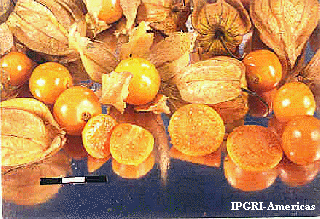
Abb.: Physalis peruviana (©IPGRI)
Vorkommen: Anden 2000 bis 3500 m. Wild in Wäldern, kultiviert, nationale Märkte, zunehmend internationaler Markt
Beschreibung: "Shrub to 1 m, propagated by seeds. Fruits globose, yellow, 1.2-2 cm in diameter, with many minute flat seeds"
Nutzung: "Pulp eaten fresh, jams, jellies. The goldenberry is an excellent source of provitamin A (3000 IU of carotene per 100 g), vitamin C and vitamin B-complex. In Colombia, it is as considered beneficial for diabetic people."
(Solanum violaefolium)
Bezeichnungen: Motojobobo
Familie: Solanaceae -- Nachtschattengewächse
Tomate (Lycopersicon esculentum)
Bezeichnungen: Tomate
Familie: Solanaceae -- Nachtschattengewächse
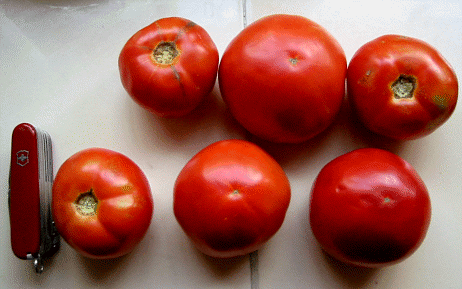
Abb.: Lycopersicon esculentum (Bild: Payer)
Limatomate (Cyphomandra betacea)
Bezeichnungen: Lima tomate
Familie: Solanaceae -- Nachtschattengewächse
Grandilla (Passiflora ligularis Juss.)
Bezeichnungen:
Sp: granadilla (Andes), granadita, granadilla de China, parchita amarilla, parcha dulce, parcha importada (Venezuela);
Po: maracujá-urucú;
En: sweet granadilla;
Fr: grenadille douce, grenadille de montagne, grenadelle.
The Latin name comes from the particularly long, ligulate, petiole nectars
Familie: Passifloraceae -- Passionsblumengewächse
|
|
|
| Abb.: Granadilla (Passiflora ligularis) (©IPGRI) | |
|
|
|
Vorkommen: Anden 1400-2400 m. Zentralamerika. Eingeführt in Jamaica und Haiti. Wild, kommerziell kultiviert
Beschreibung: "Vigorous woody vine, propagated by seeds. Self-incompatible. Leaves simple (very exceptionnally trilobate), cordate; flowers large (6-10 cm); fruit round to ovoid, tapering to the peduncle, 5-9 x 4-7 cm; pericarp thin, brittle, very smooth, onion-orange to bright orange, with light dots; pulp grayish or yellowish, very sweet, slightly acidulate. Highly polymorphic. Particular landraces are distinguished by fruit size and shape, and by the thickness of exocarp and mesocarp."
Nutzung: "Aril mostly consumed fresh, more rarely in beverages and desserts, as taste is not strong enough. The fruit has an excellent presentation, and a relatively long shell life. It is a major passion fruit in Colombia, where it is reputed as a healthy baby-food."
(Passiflora tripartita var. mollissima Holm-Nielsen & Jørgensen)
Bezeichnungen: Tumbo, Curuba
Sp: curuba de Castilla, curuba sabanera blanca (Colombia), parcha; tacso de Castilla, tacso or puru puru (Ecuador);
Po: maracujá-curuba;
En: Banana passion fruit, softleaf passion flower.
Fr: tacso, curuba.
Familie: Passifloraceae -- Passionsblumengewächse
|
|
|
| Abb.: Passiflora tripartita var. mollissima (©IPGRI) | |
|
|
|
Vorkommen: Anden, frostfreie Gebiete, 2000 bis 3500 m. Kultiviert, nationale Märkte.
Beschreibung: "Vigorous liana with pubescent stems and trilobed leaves, slightly pubescent above and densely pubescent beneath; stipules reniform, permanent; flower pendent, floral tube long (ca. 10 cm), dark green with anthocynanins, bracts oblong, disposed close to the hypanthium, sometimes torn out by its growth; fruit oblong, growing larger at higher elevations, up to 15 x 5 cm (110-180 g); pericarp soft and pale yellow, pulp bright orange, highly aromatic, somewhat tart. The pulp yield is superior to 60%. The plant and its fruits are very susceptible to anthracnosis (see lower fruits on the picture). As commonly observed in the subgenus Tacsonia, P. tripartita var. mollissima hybridizes easily with other species. The most interesting fertile hybrids for breeding have been obtained with P. tarminiana and P. mixta."
Nutzung: "Aril prepared into juices, mixed with milk or water, in many desserts where its original aroma is highly appreciated. The curuba de Castilla is a major passion fruit in Colombia, particularly on the Bogota market."
(Passiflora pinnatistipula Cav.)
Bezeichnungen: Tumbo, Curuba
Sp: granadilla de clima frío, gulupa (Colombia), tacso, puru-puru (Ecuador)
tin-tin (Peru, from Quechua).
Fr: passiflore à stipules pennées, passiflore du Chili.
Familie: Passifloraceae -- Passionsblumengewächse
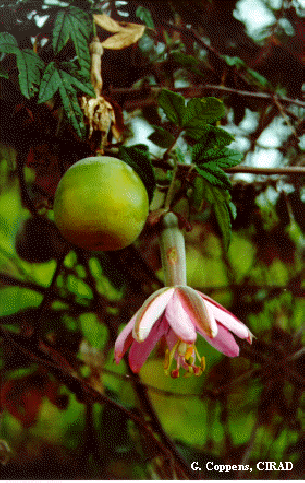
Abb.: Passiflora pinnatistipula (©IPGRI)
Vorkommen: Anden 2500 bis 3800 m. Wild, kultiviert.
Beschreibung: "Vine with coriaceous trilobate leaves, pinnate stipules. Flower pink or white, with an hypanthium intermediate in length and a short simple filamentose purple corona. These traits place this species of subgenus Tacsonia close to subgenus Passiflora. Fruit round to slightly oblong, 4-6 cm in diameter, with a thin, coriaceous, green to yellow pericarp. The pulp is grayish to yellowish, sweet, slightly acidulated, and aromatic. The seeds are relatively large and the aril scarce, but excellent. Polymorphism is much higher in Peru and Bolivia, where a second type is found, with a larger flowers witha relatively narrower hypanthium, and a larger, oval fruit."
Nutzung: "Aril eaten fresh."
(Passiflora cincinnata Mast.)
Bezeichnungen: Tumbo, Curuba
Sp: parcha de monte, parchita de monte, montera, parchita, bombolla, parcha criolla (Venezuela); pachis (Bolivia);
Po: maracujá-tubarão.
The Latin name refers to the hairy appearance of the corona.
Familie: Passifloraceae -- Passionsblumengewächse
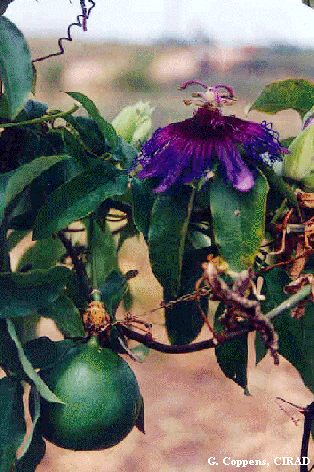
Abb.: Passiflora cincinnata (©IPGRI)
Vorkommen: Ostbrasilien, Paraguay, Argentinien, Ostbolivien. Wild, kultiviert als Schmuckpflanze oder zum Aufpfropfen
Beschreibung: "Very showy violet flowers with abundant to extremely abundant twisted filaments. The edible fruit is green, rounded, and relatively large (5 cm) but it tastes flat and does not deserve direct interest in our opinion."
Nutzung: "Edible fruit. Ornamental. Tea or guarapo. Medicinal: mouth bath against throat pains."
(Passiflora quadrangularis L.)
Bezeichnungen: Tumbo, Curuba
Sp: badea (Colombia, Venezuela), corvejo (Colombia), badera, granadilla real, granadilla grande, parcha de Guinea, parcha granadilla, parcha granadina (Venezuela), pasionaria, sandía de la pasión, tumbo costero (Peru), quijón (Bolivia), granadilla de fresco, granadilla para refrescos (El Salvador);
Po: maracujá melão, maracujá mamão, maracujá cascudo, maracujá do igapó, maracujá do Pará, maracujá grande, maracujá de quatro quinhas, maracujá-caiana, maracujá de Caiena; maracujá açú, maracujá assú, guaçú, guassú, and uaçú are the oldest Brazilian names, of Tupi-Guarani origin, referring to the size of the fruit;
En: giant granadilla, true granadilla, nutsulet, sirsijo;
Fr: barbadine, grenadine;
Du:groote markoeja (Surinam);
Dt: Granadilla.
Familie: Passifloraceae -- Passionsblumengewächse
|
|
|
| Abb.: Passiflora quadrangularis (©IPGRI) | |
Vorkommen: Tropisches Amerika, Pantropisch. Kultiviert, südamerikanischer Markt
Beschreibung: "Vigorous vine, with thick quadrangular stems, propagated by seeds or cuttings. Flowers similar to those of P. alata, 7-10 cm wide. The two species are easily crossed and produce fertile hybrids. Fruit irregularly shaped, 10-30 x 10-15 cm, yellowish green; mesocarp white and thick, arils white to yellowish."
Nutzung: "Arils eaten fresh, in beverages (including wine), desserts. Flavor subacid, variable, often insipid. The mesocarp is also used to prepare candies, jelly, and pastries. The young, unripe fruit may be cooked and served as a vegetable. The roots of old vines are consumed as a substitute for yam (Jamaica)."
Cherimoya (Annona cherimolia Miller)
Bezeichnungen: Chirimoya
Sp: anón, chirimoya (from the Quechua chirimuya), chirimoya del Perú, chirimorrinón, chirimoyo is the tree;
Po: anona do Chile, chirimólia, fruta do conde; cabeça de negro;
En: Cherimoya;
Fr: chérimole, corossol du Pérou, chérimolier or chérimoyer is the tree;
Dt.: Cherimolia, Cherimoyabaum, Peruanischer Flaschenbaum.
Familie: Annonaceae -- Rahmapfelgewächse
|
|
|
|
|
Vorkommen: Andentäler 1600 bis 2200 m. Wild, seit alters her kultiviert, moderne Züchtungen, nationale Märkte. Größter Produzent: Spanien (3000 ha Anbaufläche)
Beschreibung: "Small deciduous tree. The fruits is a syncarp containing many large black seeds. The pulp is soft, white, and very sweet."
Nutzung: "Pulp eaten fresh, drinks, sherbets, wine. One of the most delicious Annona fruits. The seeds are used ground and macerated in water to make an insecticide."
(Annona muricata L.)
Bezeichnungen: Sinini
Sp: anona, catoche or catuche (Carib), catche, guanábana, zapote agrio;
Po: graviola, anona, curassol, coração de rainha, pinha azeda;
En: soursop;
Fr: corossol, coeur de boeuf, anone, cachiman épineux; corossolier is the tree;
Du: zuurzak;
Dt: Anona, Flaschenbaum, Stachelanone,
durian belanda
nejo, suiti.
Familie: Annonaceae -- Rahmapfelgewächse
|
|
|
|
| Abb.: Annona muricata (©IPGRI) | ||
Vorkommen: Tropisches Amerika, ganze Tieflandtropen. Kultiviert seit präkulumbianischen Zeiten, Züchtungen, nationale Märkte.
Beschreibung: "Small evergreen tree, up to 10 m. Propagated by seeds or grafting (germination in 30 days; orthodox). Dichogamous flowers, solitary. The fruit is an ovoid syncarp, 15-40 x 10x20 cm, weighing 2-4 kg, green, with a white sweet pulp. The fruitlets are generally apiculate, but quite smooth in certain cultivars. Numerous dark seeds, 1-2 cm long. Highly polymorphic."
Nutzung: "Industrial: juice, drinks, pulp for yogurt. Pulp is also eaten fresh or made into sherbets and jams. It does not get oxydized as that of other Annona fruits. Juice is considered to be a tonic and vermifuge. Buds and leaves are used as a sedative and antispasmodic, as well as antitussive and against fever and diabetes. The fruits are considered antidiaretic. The seeds are used ground and macerated in water to make an insecticide."
(Annona reticulata L.)
Bezeichnungen: Chirimoya roja
Sp: anón, anona, anona colorado, anona corazón, anona de Cuba, anona pelón, anón manteca, corazón, mamón;
Po: fruto da condessa, coração de boi, milolo;
En: bullock-heart, custard apple, Jamaica apple, sweetsop;
Fr: coeur de boeuf, cachiman, cachimantier is the tree;
Dt: Custardapfel, Ochsenherzapfel.
Familie: Annonaceae -- Rahmapfelgewächse
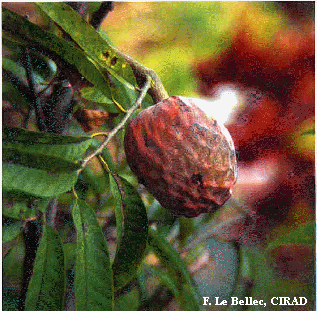
Abb.: Annona reticulata (©IPGRI)
Vorkommen: Tropisches Amerika, pantropisch; kultiviert, lokal vermarktet
Beschreibung: "Small tree, up to 7 m. Fruit ovoid, 8-12 cm in diameter and 400-1000 g; reddish with a white pulp."
Nutzung: "Pulp eaten fresh, juice, sherbets. The astringent leaves and green fruits are used to make a tea with anti-diarrheic and sedative properties. The seeds are used ground and macerated in water to make an insecticide."
Annone (Annona squamosa L.)
Bezeichnungen: Anon
Sp: anón, anona, anona blanca, anonillo, atta del Brasil, chirimoya, rinón, saramuyo;
Po: ata, fruta da condessa, fruta de conde, pinha;
En: custard apple, sugar-apple, sweetsop;
Fr: anone écailleuse, pomme canelle, atte; corossolier écailleux and attier refer to the tree;
Dt: Kanelapfel, Zimtapfel
Familie: Annonaceae -- Rahmapfelgewächse
|
|
|
| Abb.: Annona squamosa (©IPGRI) | |
Vorkommen: Tropisches Südamerika, pantropisch. Kultiviert, Züchtungen, nationale und lokale Märkte.
Beschreibung: "Small tree up to 6 m. Fruit ovoid, 5-10 cm in diameter, solitary; green with white pulp."
Nutzung: "Pulp eaten fresh, juice, sherbets. Leaves used in poultice against certain skin infections. The seeds are used ground and macerated in water to make an insecticide."
(Annona nutans Fries)
Bezeichnungen: Araticu
Familie: Annonaceae -- Rahmapfelgewächse
Vorkommen: Tropisches Südamerika. Wild, gesammelt.
Nutzung: "Pulp eaten fresh"
(Annona dioica)
Bezeichnungen: Sinini del oriente
Familie: Annonaceae -- Rahmapfelgewächse
(Porcelia safflordiana)
Bezeichnungen: Lucuma
Familie: Annonaceae -- Rahmapfelgewächse
(Duguetia ibonensis)
Bezeichnungen: Duguetia
Familie: Annonaceae -- Rahmapfelgewächse
(Trigynaea periquino)
Bezeichnungen: Periquino
Familie: Annonaceae -- Rahmapfelgewächse
(Guatteria ponderosa)
Bezeichnungen: Guatteria
Familie: Annonaceae -- Rahmapfelgewächse
(Pseudolmedia hirtellaefolia)
Bezeichnungen: Nui
Familie: Moraceae -- Maulbeergewächse
(Pouroma uvifera)
Bezeichnungen: Uva del monte
Familie: Moraceae -- Maulbeergewächse
(Cecropia leucocoma)
Bezeichnungen: Ambaiba
Familie: Moraceae -- Maulbeergewächse
(Prunus serotina)
Bezeichnungen: Capuli árbol
Black Cherry, Black Choke, Cabinet Cherry, Rum Cherry
Familie: Rosaceae -- Rosengewächse
Nutzung: "Pulp eaten fresh, Timber, Medicinal"
(Hirtella stipitadenia)
Bezeichnungen: Urura
Familie: Rosaceae -- Rosengewächse
(Rubus spp.)
Bezeichnungen: Kari-kari
Familie: Rosaceae -- Rosengewächse
(Rheedia madruno Planch. & Triana)
Bezeichnungen: Kamururu
Sp:madroño;
Po: cozoiba;
En: madrono;
Fr: madruno.
Familie: Clusiaceae (Guttiferae)
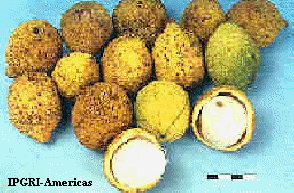
Abb.: Früchte von Rheedia madruno (©IPGRI)
Vorkommen: Südamerika, wild in Anden, gesammelt, selten in Hausgärten kultiviert
Beschreibung: "Tree to 8 m, propagated by seeds. Up to 14 flowers in the leaf axils. Fruits round, yellow, 3-6 cm; pulp scarce, white."
Nutzung: "Aril eaten fresh. Flavor sub acid, very pleasant, similar to mangosteen. cultivated as ornamental or shading tree."
(Rheedia achachairu)
Bezeichnungen: Achachairú del Beni
Familie: Clusiaceae (Guttiferae)
(Rheedia lateriflora)
Bezeichnungen: Achachairú de Santa Cruz
Familie: Clusiaceae (Guttiferae)
(Rheedia acuminata)
Bezeichnungen: Ocoro crespo
Familie: Clusiaceae (Guttiferae)
(Rheedia brasiliensis)
Bezeichnungen: Guapomo
Familie: Clusiaceae (Guttiferae)
Lucuma (Lucuma obovata H.B.K.)
Synonyme: Achras lucuma R. & P.; Lucuma bifera Mol.; Lucuma turbinata Molina; Pouteria insignis Baehni; Pouteria lucuma (R. & P.) Kuntze; Richardella lucuma (R. & P.) Aubreville.
Bezeichnungen: Lucuma
Sp: lucuma, lucmo, lucuma.
Familie: Sapotaceae
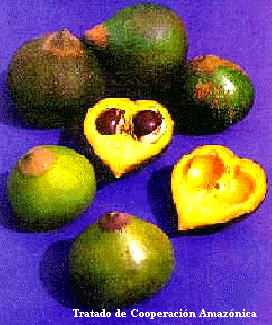
Abb.: Lucuma obovata (©IPGRI)
Vorkommen: Anden bis 3000 m. Wild, kultiviert
Beschreibung: "Tree to 15-20 m, propagated by seeds (germination in 25-90 days) and grafting, producing an abundant milky latec. The fruit is a spherical or conical berry, 2-10 cm in diameter, green. The mesocarp is yellow with a gritty texture. It is very sweet, and permeated with latee until full maturity. It contains 1-5, usually 2, rounded, dark-brown, glossy seeds"
Nutzung: "Pulp eaten fresh, or dried and ground into a yellow flour for the preparation of pastries, including ice-cream. Also stewed in syrup and made into preserves. Commonly consumed in Peru. The wood is pole, compact, durable, and used for construction in Peru."
(Lucuma polycarpa)
Bezeichnungen: Polycarpa
Familie: Sapotaceae
(Vitex pseudolea)
Bezeichnungen: Aceitunilla
Familie: Verbenaceae
(Genipa americana L.)
Synonyme: Genipa excelsa Krause, Genipa oblongifolia R. & P.
Bezeichnungen: Bi
Sp: genipa, bilito, cafecillo denta, caruto rebalsero, guaricha, guaitil, guayatil colorado, huitoc, huito, huitu, jagua, jagua amarilla, jagua blanca, jagua colorado, maluco, nandipa, totumillo, tapaculo;
Po: genipapo, jeipapeiro, yenipapa, mandipa;
En: genipap, juniper, marmeladebox;
Fr: confiture de singe, génipa; genipayer is the tree;
Du: taproepa, tapoeripa.
Familie: Rubiaceae
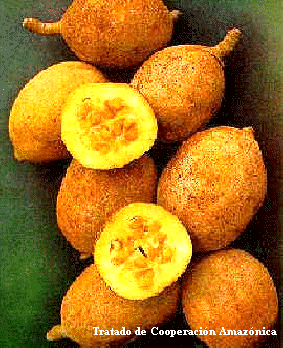
Abb.: Genipa americana (©IPGRI)
Vorkommen: Tropisches Südamerika, auf gut bewässerten Böden und periodisch überfluteten Flussufern. Wild, in Hausgärten kultiviert
Beschreibung: "Tree to 10-20 m, propagated by seeds or grafting. Trunk 30-80 cm in diameter, with abundant vertical ramifications. Leaves concentrated at the branch apex. The fruit is a globose to ovoid berry, 10-12 x 7-9 cm, 200-400 g, grey turning reddish brown at maturity. Although soft, it resists transportation. The pericarp is yellowish grey, spongy, 1.5 cm thick. The pulp is juicy, bittersweet, and astringent. The seeds are numerous (ca. 300). Pericarp and pulp are aromatic. The seeds show an intermediate behaviour during conservation. Seeds can be dried down to 10%, which induces dormancy. Germination is rapid and uniform."
Nutzung: "Pulp eaten fresh, desserts, non alcoholic beverages, syrups, wines and jams. Mixed with other liquors to prepare beverages (huitochado, jenipapada). The green fruit gives a yellow juice turning gradually to very dark blue, used by the natives for dying their hair, painting their body, their clothes, and diverse objects. This very common use is probably the reason why the tree is so dispersed in all tropical America. The huitochado is recommended against rheumatism. Amerindians make a syrup from the juice of the mesocarp or cook the fruit and seeds and use the residual water against asthma and to reduce inflammations of the respiratory system. The fruit pulp is used as a dental anesthetics. The scraped green fruit is used against itching."
(Alibertia tutumilla)
Einheimische Bezeichnungen: Tutumilla, Bicito
Familie: Rubiaceae
Paranussbaum (Bertholetia excelsa Humb. & Bonpl.)
Bezeichnungen: Almendra del Beni
Sp: castaña del Brasil, nuez del Brasil, nuez de Pará, almendrón, jubia, yubia, castaño de Pará;
Po: castanheira, castaña do Brasil, castaña do Pará, castaña do moranhão;
En: Brazil nut, Para nut;
Fr: noix du Brésil, noix de Para, amande d'Amérique; châtaignier du Brésil, noyer de Para, for the tree;
Dt: Brasilianische Kastanien, Paranuss
Familie: Lecythidaceae
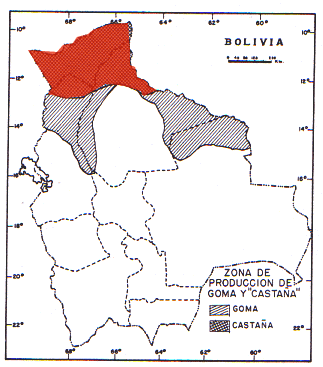
Abb.: Anbaugebiete des Paranussbaums
[Kartenvorlage: Muñoz Reyes, Jorge <1904 - 1984>: Geográfia escolar de Bolivia. -- 3. ed., actualizada. -- La Paz : Juventud, 1997. -- Depósito legal 4-1-068/81. -- S. 151]
|
|
|
| Abb.: Bertholetia excelsa (©IPGRI) | |
Vorkommen: Amazonien. Wild, gesammelt, kultiviert, internationaler Markt
Beschreibung: "Very large tree to 60 m, propagated by seeds or grafting. The fruit is a capsule spherical to ovoid, 10-25 cm in diameter, 200-2,000 g, brown. About 18 seeds/fruit, containing a white almond in a coriaceous shell."
Nutzung: "The almond is eaten fresh or roasted; it is highly nutritious, with good quality proteins (equivalent to milk). The oil is easy to digest. It is also used for high quality soap and in the cosmetic industry. The residue of oil extraction gives a high protein flour that can be mixed with common bread flour or used in animal feeding. The fruit shell is used local with craftsmen. Good quality wood. The tree can be associated with other perennial crops, such as cocoa, guarana, and pepper."
(Eugenia edulis)
Bezeichnungen: Guapúru
Familie: Cauliflora
Guave (Psidium guajava L.)
Bezeichnungen: Guayavo
Sp: guayaba; the tree is called guayabo;
Po: goiaba, goiaba, goiabeira, goiabeira branca, goiabeira vermelha, goiabeira pera, araçá goiaba;
En: common guava, apple guava, tropical guava, yellow guava, guava;
Fr: goyave, the tree is called goyavier.
Du: guyaba, goeajaaba, guave, goejaba (surinam);
nulu, purijo, pichi, posh, enandi (Amerindian).
Familie: Myrtaceae
|
|
|
| Abb.: Psidium guajava (©IPGRI) | |
Vorkommen: Tropisches Amerika, pantropisch und subtropisch. Kultiviert, über 150 Rassen, Nationale Märkte. Internationaler Handel mit industriellen produkten
Beschreibung: "Tree to 10 m, propagated by seeds (germination in 15-60 days), cuttings, layering, and grafting. Fruit spherical, ellipsoid, or pyriform, very odorous; 3-8 cm in diameter, white or yellow, sometimes with pink blush, pulp white with a variable, but high content of vitamin C., yellow, or red, sweet to mighty acid; seeds numerous (several hundreds), small, very hard, yellowish. Some guavas are nearly seedless. Pollination by honey-bees"
Nutzung: "Juice (industrial), pulp eaten fresh or cooked, and used to prepare jellies, syrups, ice-creams and preserves. Guave paste commonly used in pastry. Transport limited by the fruit fragility. The fruit is effective against diarrheas and digestive disorders. Leaf decoction are used as a remedy for coughs, throat and chest ailments, gargled to relieve oral ulcers and inflamed gums, as an emmenagogue and vermifuge, treatment of lencorrhea; it has been effective against vomiting and diarrhea in cholera patients. Also used to clean wounds and accelerate healing (Madagascar). Wood used in carpentry and turnery. Good fuelwood. The bark is used for tanning ludes (Central America). Black dye from leaves (Malaysia)."
(Psidium acutangulum)
Bezeichnungen: Guabirá
Familie: Myrtaceae
(Aulomyrcia leucadendron)
Bezeichnungen: Sahuintu
Familie: Myrtaceae
(Hancornia speciosa Gomes)
Synonyme: Hancornia gardneri Muell. Arg., Hancornia lundii A.D.C. Hancornia pubescens Muell. Arg., Ribeirea sorbilis Arr. Cam.
Bezeichnungen: Mangaba
Sp: mangaba;
Po: mangabeira, mangabinha do Norte;
En: mangaba tree;
Fr: caoutchouc de Pernambouc.
Familie: Apocynaceae
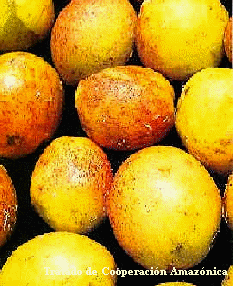
Abb.: Hancornia speciosa (©IPGRI)
Vorkommen: Amazonien. "The mangaba is found in the transition between the cerrado and the tropical Atlantic forest, on sandy, podzolic, and lateritic soils." Wild, gessammelt, kultiviert
Beschreibung: "Tree to 7 m rarely 15, propagated by seeds (germination in 18 days; recalcitrant). The fruit is an ellipsoid or spherical berry, 2,5-6 cm in length, greenish yellow, striated with red lines; pulp white, sweet acidulate viscous, containing 2-15 discoid seeds, about 1 cm in diameter. H. speciosa var. minor is distinguished by its much smaller fruits."
Nutzung: "Pulp eaten fresh, made into juices, syrups, compotes, sherbets, ice-cream (small industry), wine and vinegar. All the plant parts, including the roots, produce a white latex used to make a gum. During World War II, 2,000-2,500 tons of this gum were produced as a substitute to the hevea gum. The production reaches more than one liter of latex in two hours and the extraction is lesslabor-intensive than for Hevea. The latex in the fruit is an advantage in the preparation of ice-creams and gelatins. In traditional medicine, this latex is used against tuberculosis. The wood may be used for construction. It has a good calorific potential."
Ananas (Ananas spp.)
Vor allem: Ananas comosus (L.) Merr.
Bezeichnungen: Ananas, Avakachi, Piña
Familie: Bromeliaceae
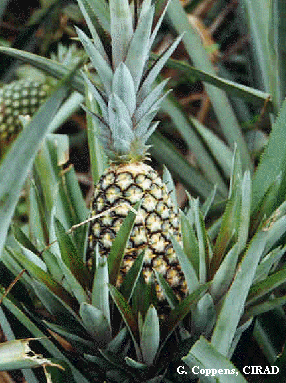
Abb.: Ananas comosus (©IPGRI)
Vorkommen: Nördliches tropisches Südamerika, pantropisch. Kultiviert, traditionelle und moderne Züchtungen. Internationaler Handel
Beschreibung: "Highly variable herb to 1-2 m in height and width, organized in a rosette with very short internodes and terminal inflorescence. Wide spiny leaves. Spines partially or totally absent in certain cultivars. Fruits syncarpic (50-200 fruitlets), parthenocarpic, green, yellow, orange, red, or dark purple at maturity, 10-30 cm long and more, 0.5-13 kg; pulp white to yellow, sweet, acidity variable. Seedless because of self-incompatibility. Fruit production in 12-36 months, according to mean temperature. Propagated vegetatively by crowns, slips, and suckers (seeds only used in hybrid breeding)."
Nutzung: "Pulp eaten fresh or processed: juice, canned (slices and chunks), frozen, dried, juice, and jams. Wine and guarapo. Bromelain (proteolytic enzyme) used as a meat tenderizer, a nutraceutical, and in modern medicine; traditional medicine :emmenagogue, abortifacient, antiamoebic, vermifuge, correction of stomach disorders, and poisoning of arrow points. Modern studies have confirmed the emmenagogue and abortifacient effects of green pineapple. Animal feed (transformation residues). Fiber (piña cloth, special papers). "
(Guilielma insignis)
Bezeichnungen: Tembe
Familie: Arecaceae (Palmae) -- Palmengewächse
(Orbygnya phalerata Mart.)
Synonyme: Orbygnia martiana Barb. Henderson et al. (1995), consider O. phalerata Mart. and O. martiana Barb. Rodr. as synonyms of Attalea speciosa Mart. ex Spreng.
Bezeichnungen: Cusi
Sp: babasú, shapaja, cusi, catirina;
Po: babaçú; bagassú, coco de macaco, aguassú;
En: babasu palm.
Familie: Arecaceae (Palmae) -- Palmengewächse
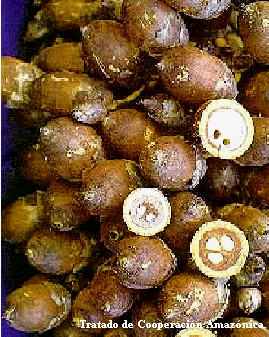
Abb.: Orbygnya phalerata (©IPGRI)
Vorkommen: Amazonien.Wild, meist gesammelt, selten kultiviert
Beschreibung: "Androdioecious palm, single trunk, to 30 m. Propagated by seeds. Heat stimulates germination. Each bunch weighs 15-90 Kg and is constituted by 200-600 fruits. Fruit elliptic to oblong, 6-12 x 4-10 cm, 40-440 g in dry weight."
Nutzung: "All part of the plant are used, with an economical value estimated 85,000,000 US$ in Maranhão State. Main use is the extraction of oil, similar to coconut or oil palm, with low yield, for the oil and soap industry. The seed is eaten fresh. The endocarp is used to make an excellent charcoal. The mesocarp is a source of starch for feeding animals and producing alcohol. Young plants give palmito. Leaves are used for roofing and fibers for basketry, tapestry, and nets. Tender leaves around the bud are used as a forage."
(Acrocomia totai Mart.)
Bezeichnungen: Totai
Sp: totai, palma de vino, mocaya, cayiete, ocori, gru gru;
Po: grou, grou, mucaya, uba, mujuca, noz de Paraguai.
Familie: Arecaceae (Palmae) -- Palmengewächse
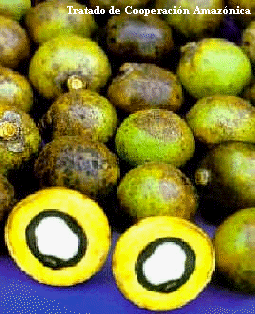
Abb.: Acrocomia totai (©IPGRI)
Vorkommen: Ostbolivien und angrenzende Gebiete. Wild, gesammelt
Beschreibung: "Monoecious palm to 13-20 m, propagated by seeds. The fruit is a globose drupe, yellow, 2.5-3 cm in diameter, with a hard exocarp and a fibrous yellow mesocarp."
Nutzung: "Nut eaten roasted. A liquor is made from the fermentation of the sweet pulp. The trunk contains a starchy substance used to make bread and cakes. The heart can be used as palmito. The macerated leaves are used to make ropes. The oil is used for food and soaps."
(Attalea princeps)
Synonym: Attalea phalerata Mart. ex Spreng.
Bezeichnungen: Motacu
Sp: motacú, shapaja;
Po: urucuri, naia.
Familie: Arecaceae (Palmae) -- Palmengewächse
Vorkommen: Anden
Nutzung: Nuss (l)
(Astrocaryum chonta)
Bezeichnungen: Chonta
Familie: Arecaceae (Palmae) -- Palmengewächse
(Euterpe andicola)
Bezeichnungen: Assai
Familie: Arecaceae (Palmae) -- Palmengewächse
(Bactris major Jacq. var. infesta)
Bezeichnungen: Marayahu
Sp: marayáu (Bolivia), corozo de gallina, lata (Colombia), huiscoyol (El Salvador, Guatemala, Honduras, Nicaragua), jahuacté (Mexico), caña brava (Panama), cubarro, moporo (Venezuela), viscoyol;
Po: marajá;
En: beach palm, beach spiny club palm, hones (Belize);
Fr: zagrinette
Familie: Arecaceae (Palmae) -- Palmengewächse
Vorkommen: Zentralamerika, nördliches Südamerika
Beschreibung: "Stem forming dense clumps, 10m, 2.6cm wide, with spines 5cm long; fruits ellipsoid or obovoid, 2.5-4.5x1.3-3.5, apiculate, purple black; mesocarp yellowish, fibrous and juicy "
Nutzung: "Pulp eaten fresh, drinks;nut"
(Avecastrum romanzoffianum var. botiyophorum)
Bezeichnungen: Sumuque
Familie: Arecaceae (Palmae) -- Palmengewächse
(Parajubaea torallyi)
Einheimische Bezeichnungen: Janchi coco, Palmeta de pasopaya
Familie: Arecaceae (Palmae) -- Palmengewächse
Papaya (Carica papaya L.)
Bezeichnungen: Papaya, Mamao
Sp: papaya, lechosa (Venezuela), fruta bomba, papanajo;
Po: mamão;
En: paw paw, tree melon, papaya;
Fr: papaye; papayer is the tree
kwarkwatta.
Familie: Caricaceae
|
|
|
|
|
|
|
|
|
Vorkommen: Tropisches Amerika, pantropisch. Kultiviert, moderne Züchtungen. Bedeutende Handelsfrucht
Beschreibung: "Semi-lignose, single stem to 8 m; with three main sexual types (male, female, hermaphrodite). Propagation by seeds. Fruit spherical to ellipsoid, 10-30 cm long, 400-2,500 g, solitary or in small clusters; external color yellow to orange; internal color yellow, orange, or red. Numerous black or gray seeds."
Nutzung: "Pulp eaten fresh, made into juice, preserves, desserts. Immature pulp used as a vegetable. Leaves consumed like spinach. Seeds used as vermifuge. The proteolytic enzyme papainase is used in breweries (to clarify beer), as a meat tenderizer in the food industry, and in pharmacy. The latex is used in the treatment of dermatoses."
(Carica candamarcensis)
Bezeichnungen: Papaya de altura
Familie: Caricaceae
(Carica quercifolia)
Bezeichnungen: Gargatea
Familie: Caricaceae
Feigenkaktus (Opuntia ficus-indica Mill.)
Bezeichnungen: Tuna
Sp: nopal, cardón de México, chumbera, chumbo, chumbua, higo chumbo, higo de pala, higo México, higuera de pala, nopal de castilla, tuna de España, tuna española, tuna mansa, tuna, higo chimbo, tuna real;
Po: figo da India, figo de pitoira, figueira da India, palmatoria sem espinhos, tabaido;
En: Barbary fig, Indian fig, prickly-pear;
Fr: chardon d Inde, figue de Barbarie, figuier à raquettes, figuier d'Inde, opunce, raquette;
Dt.: Feigenkactus, indianische Feige.
Familie: Cactaceae -- Kakteengewächse
|
|
|
| Abb.: Opuntia ficus-indica (Bild: Payer) | |
Vorkommen: Kultiviert
Beschreibung: "Cactus up to 2-3 m high. Propagation by seeds, more commonly by cuttings. Fruit 4-9 cm long, purple or red. The red pulp contains many small seeds."
Nutzung: "Pulp eaten fresh, dried, made into compotes, jellies, candy, preserves, "tuna cheese", alcoholic and non-alcoholic beverages. The plant is also used as a living fence."
(Opuntia arcei)
Bezeichnungen: Tuna blanca
Familie: Cactaceae -- Kakteengewächse
(Opuntia spp.)
Bezeichnungen: Tunilla
Familie: Cactaceae -- Kakteengewächse
(Opuntia cochabambensis)
Bezeichnungen: Airampu de valle
Familie: Cactaceae -- Kakteengewächse
(Cereus hankeanus Web.)
Einheimische Bezeichnungen: Puca ulala, Velo
Familie: Cactaceae -- Kakteengewächse
(Cereus huilunchu)
Bezeichnungen: Huilunchu
Familie: Cactaceae -- Kakteengewächse
(Cereus comparapanus)
Bezeichnungen: Caracore de comarapa
Familie: Cactaceae -- Kakteengewächse
(Cereus dayami)
Bezeichnungen: Caracore de Santa Cruz
Familie: Cactaceae -- Kakteengewächse
(Mediocactus coccineus)
Bezeichnungen: Pitajayas
Familie: Cactaceae -- Kakteengewächse
(Corryocactus melanotrichus)
Bezeichnungen: Kcusa-Kcusa
Familie: Cactaceae -- Kakteengewächse
(Eriocereus tephracanthus)
Einheimische Bezeichnungen: Ulala, Pasakana
Familie: Cactaceae -- Kakteengewächse
(Neocardenasia herzogiana)
Einheimische Bezeichnungen: Kalapari, Carapari
Familie: Cactaceae -- Kakteengewächse
(Trichocereus bridgesii)
Bezeichnungen: Achuma de La Paz
Familie: Cactaceae -- Kakteengewächse
(Trichocereus spp.)
Bezeichnungen: Pasakanas de Chiquisaca, Potosí y Tarija
Familie: Cactaceae -- Kakteengewächse
(Trichocereus tunariensis)
Bezeichnungen: Pasakana del Tunari
Familie: Cactaceae -- Kakteengewächse
(Cleistocactus herzogianus)
Bezeichnungen: Sitikiras
Familie: Cactaceae -- Kakteengewächse
(Ziziphus mistol)
Bezeichnungen: Mistol
Familie: Rhamnaceae
(Geoffrea decorticans)
Bezeichnungen: Chañar
Familie: Fabaceae (Leguminosae) -- Hülsenfrüchtler
(Capparis salicifolia)
Bezeichnungen: Sacha sandia
Familie: Capparidaceae
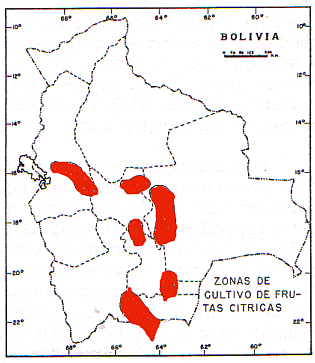
Abb.: Anbaugebiete von Zitrusfrüchten
[Kartenvorlage: Muñoz Reyes, Jorge <1904 - 1984>: Geográfia escolar de Bolivia. -- 3. ed., actualizada. -- La Paz : Juventud, 1997. -- Depósito legal 4-1-068/81. -- S. 149]
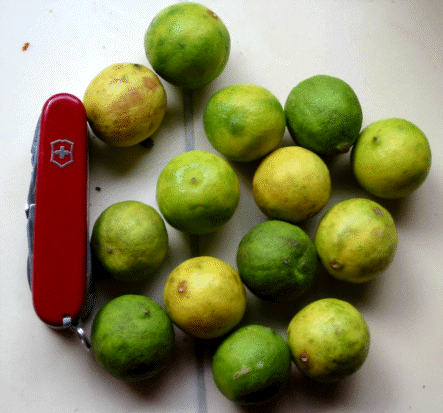
Abb.: Mini-Zitronen (Bild: Payer)
Banane (Musa paradisiaca L.)
Bezeichnungen: banano, plátano
Familie: Musaceae -- Bananengewächse
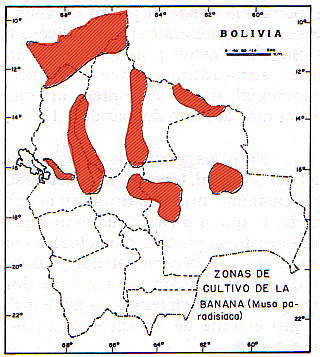
Abb.: Anbaugebiete von Bananen
[Kartenvorlage: Muñoz Reyes, Jorge <1904 - 1984>: Geográfia escolar de Bolivia. -- 3. ed., actualizada. -- La Paz : Juventud, 1997. -- Depósito legal 4-1-068/81. -- S. 151]
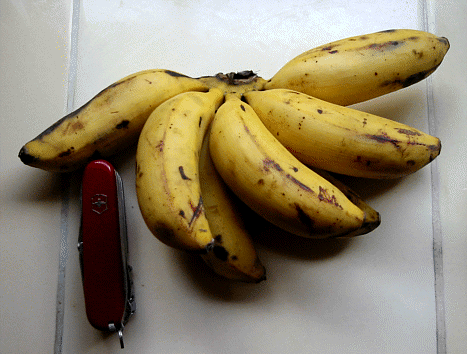
Abb.: Bananen (Musa paradisiaca) (Bild: Payer)
Zuckerrohr (Saccharum officinarum L.)
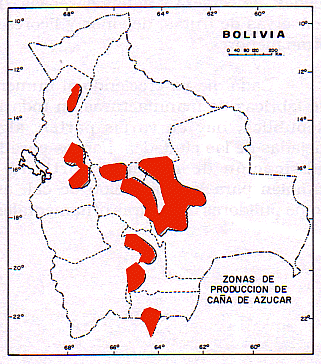
Abb.: Anbaugebiete von Zuckerrohr
[Kartenvorlage: Muñoz Reyes, Jorge <1904 - 1984>: Geográfia escolar de Bolivia. -- 3. ed., actualizada. -- La Paz : Juventud, 1997. -- Depósito legal 4-1-068/81. -- S. 153]